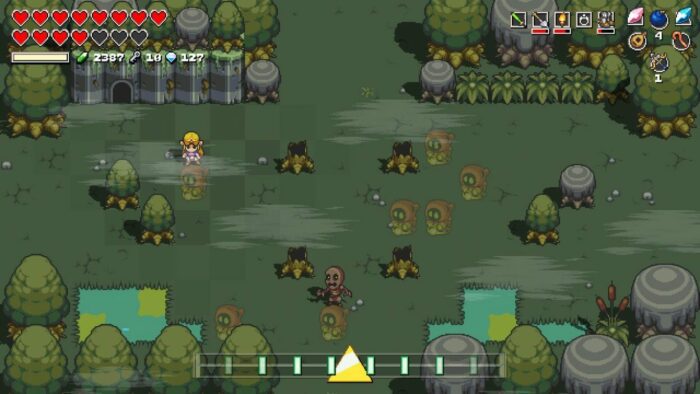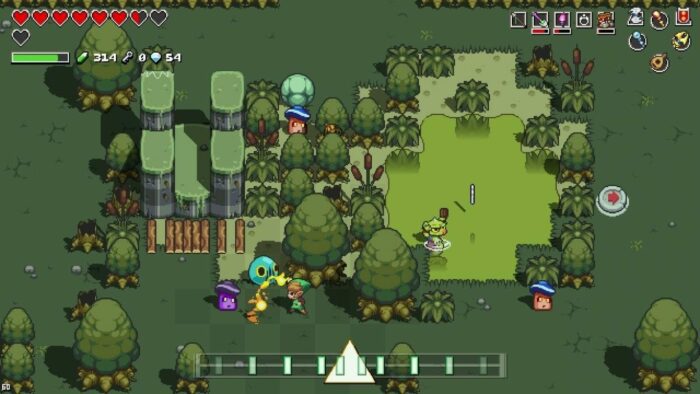Nintendo is a company notorious for keeping an iron grip on their Intellectual Properties, which shouldn’t come as much of a surprise to anyone that’s subjected themselves to the Super Mario Bros movie. While as a company they generally do a good job keeping their IPs fresh with constant new installments (and in the case of everyone’s favorite mustached plumber, various spin-offs), they seem remiss to allow anyone but their trusted second-party developers to touch their franchises. It’s why last year’s awkwardly named Cadence of Hyrule: Crypt of the Necrodancer Featuring The Legend of Zelda was such a big surprise. Not only did they let another, relatively untested developer handle one of their most lucrative and beloved IPs, but the game actually turned out great. Let’s dive in to see how Brace Yourself Games managed to put their own spin on a classic series, and how that should be a doorway to Nintendo letting developers do interesting things with their IPs.
For those not in the know, the original Crypt of the Necrodancer offers players a wonderfully unique spin on the rouge-like genre. Like the oldest games in the genre, you move along tile based floors that have randomly generated layouts, enemy placements, and upgrades. The catch here is that instead of moving when you move, enemies move to the beat of the music. You are also supposed to do that, and successful movement gives you increased bonuses such as more money earned and increased damage. It’s a simple but oh-so-fun spin on a well worn genre, and in hindsight, is a perfect fit for the musically centered Legend of Zelda franchise.

Whereas the original CotN was structurally a rogue-like through and through, Cadence of Hyrule uses many of the same elements from CotN, but structures it like a 16 bit Zelda adventure, largely aping the much loved A Link to the Past in terms of art design and critical path. In the beginning, you can choose to start as either Link or Zelda (you can get the other about a third of the way through the game, so ultimately your choice isn’t as important as it initially seems), and after a brief opening establishing that Hyrule has come under fire from musically themed bosses, players are let loose in an exceptionally open ended world that feels at times like a 2D Breath of the Wild in terms of exploration.
Rather than having an entirely generated world, instead each playthrough rearranges where different screens are located. For instance, in my first file, the Lost Woods was on the Western side of the map, and the Gerudo Desert was in the North West. A friend of mine had their Gerudo Desert in the south east and their Lost Woods in the North East. It’s a great way to encourage replayability while still having a hand crafted overworld that the main series is known for.
Like other Zelda games, there are secrets galore for intrepid players to find in Hyrule. Certain screens might have a chest that only opens when beating all the enemies without taking damage. Others might hold a golem mini boss that rewards them with a piece of heart or, better yet, a brand new weapon. Classic items like the Biggoron Sword and Kokiri Sword from Ocarina of Time pop up as one of several possible weapons, and each one falls into a particular weapon class from CotN. For instance, the Biggoron Sword allows you to attack the four tiles directly in front of your character, while the Kokiri Sword has the highest attack in the game but can only attack a tile directly in front of it. It makes character builds important, and requires the player to make split-second decisions about their positioning.
Granted, this is a much, much easier game than both A Link to the Past and Crypt of the Necrodancer. Both games are unafraid to punish the player for their mistakes, but CoH reaches a point where the threat of death is very low, even for someone like me, who has the sense of rhythm of half a coconut stuffed with stale rice. It means that you can take risks without worrying too much about any severe punishment or loss of progress (death makes you lose all your rupees, but you keep items and equipment you’ve found). It’s a nice way to ease players into the sometimes punishing gameplay style of CotN while remaining accessible.
Between the relatively sizable overworld jammed with secrets for players to find (including more than one new player character, further adding to the game’s replayable nature), and the dungeons that combine the traditional Zelda puzzles with the raw combat of CotN, and you have a gamethat unmistakably captures the spirit of the Zelda series while still managing to feel unique in its gameplay. It is, simply put, everything a good spin-off should be. Oh, and I think this goes without saying, but the soundtrack is an absolute banger.

What does all of this mean for Nintendo? I think it shows that, given the right developer, they are willing to hand the reigns over. Every second of playing Cadence of Hyrule shows that Brace Yourself Games are themselves massive Zelda fans, from the gorgeous pixel graphics, the remixed soundtrack of classic Zelda tunes, and the way they captured the feel of some of the best games in the series while injecting it with their own brand of fun gameplay. The game’s ending teases Cadence, the protagonist of CotN, winding up in another unknown realm, hinting that Brace Yourself Games might have the license to adapt more Nintendo properties in the future, which I’m all for.
I’m hoping the game serves as a wake-up call for Nintendo. I’ve been a lifelong fan of theirs, and I believe that they are among the most consistent company in all of gaming. Sure, not every game of theirs is an Ocarina of Time or Super Mario Galaxy, but I genuinely can’t remember the last time I played a game with their stamp on it that I would call outright bad. They have several IPs they aren’t really doing much with, like Metroid, F Zero, and the Wario sub-series. It makes me wonder what else is possible if they find developers like Brace Yourself Games, people that are lifelong fans of the source material and hold an understanding of what makes a particular series work. Spin-offs in general tend to be hit or miss, since it’s often a different gameplay type than what fans are used to, but I think Nintendo has enough experience in the industry to find those smaller developers that will do their IPs justice.

